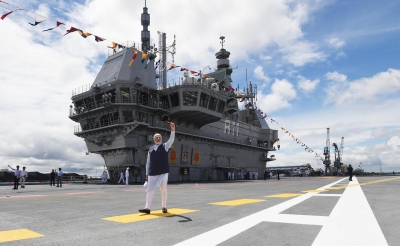Kolkata 3rd September : The country was cheering at the time that Indias first Indigenous Aircraft Carrier (IAC) INS Vikrant was officially inducted into the Indian Navy by Prime Minister Narendra Modi.Except for a handful of people, nobody was informed of the 72 hours of intense work that were the deciding factor for the project in its early days.
The decision to construct the carrier could have had been scrapped if engineers and metallurgists failed to sort out a matter concerning the steel used to be used for the flight deck.Indigenisation, and to a degree of more than 76 percent was not the main goal when designers began working on the massive 45,000-tonne rig in 2002.
The estimate was that around 27,000 tonnes of high-quality steel (of three kinds) would be needed to complete the project.Indian shipyards built warships, however the steel was imported.
“When India went in search of steel for the IAC there were no buyers.There could be a variety of causes for this.
One of reasons could be that no one was able to supply that much.Also, it could be the case that no one was willing to supply steel to India to build an aircraft carrier, as foreign powers demanded that we continue the import of these vessels.
The first two aircraft carriers we had were second-hand ones, after all.After realizing that the steel was not able to be purchased from the United States, Defence Metallurgical Research Laboratory (DMRL) came up with specifications.Heavy Engineering Corporation (HEC) Ltd, Ranchi, succeeded in making some ingots, but the production of large quantities was required.Steel Authority of India Ltd (SAIL) was up to the task,” a source revealed.
Three kinds of steel were needed for the air carrier.DMR 249 Grade-A steel was needed for the hull and the superstructure of the carrier aircraft.
The Bhilai and Bokaro Steel Plants started to manufacture this.
The second one, DMR 249 Grade-B, was more distinct.It was designed to make the flight deck and required to be extremely durable (to endure the pressure as aircraft take off) but also flexible (to return to its initial position following every takeoff).The steel was manufactured at Alloy Steel Plant (ASP) in Durgapur, West Bengal.
The third type that was required in tiny quantities was Z-25.It was used as floor of the machines, and was designed to stand up to compression of 25 percent because of the pressure.
The steel plates created at ASP did not go straight to Kochi however.They were first transported to the Rourkela Steel Plant (RSP) for special treatment in order to make them tough and hard.
At RSP the plates first underwent a process of water quenching to make them harder.A second round of “tempering” was then followed to make them stronger.
There was then a third round of water quenching prior to the DMR 249 Grade-B plates were able to achieve their unique characteristics.
“Everything was going smoothly until the first batch of DMR 249 Grade-B plates experienced internal stress within six months of the date of delivery.
We were given just three days (72 hours) to find a solution.with an answer.
DMRL did not have any ideas about this issue.There is any aircraft carrier with no flight deck at all.
“In the span of three days our metallurgists and engineers have come up with two methods to reduce internal stress.We took one of these and then supply was restored,” the source added.
jayanta/
.







